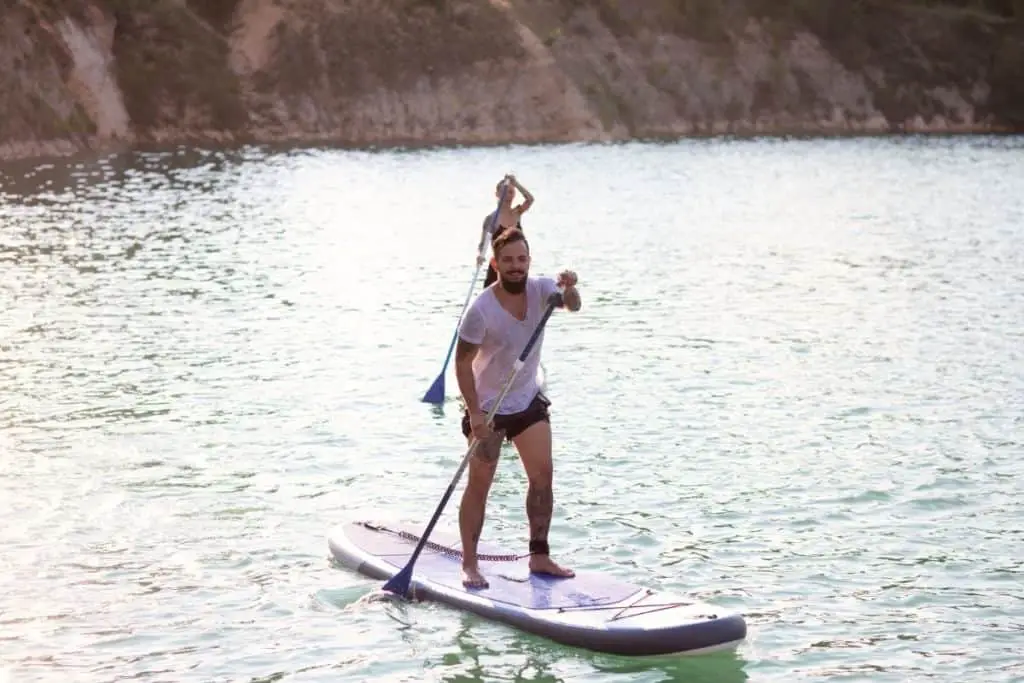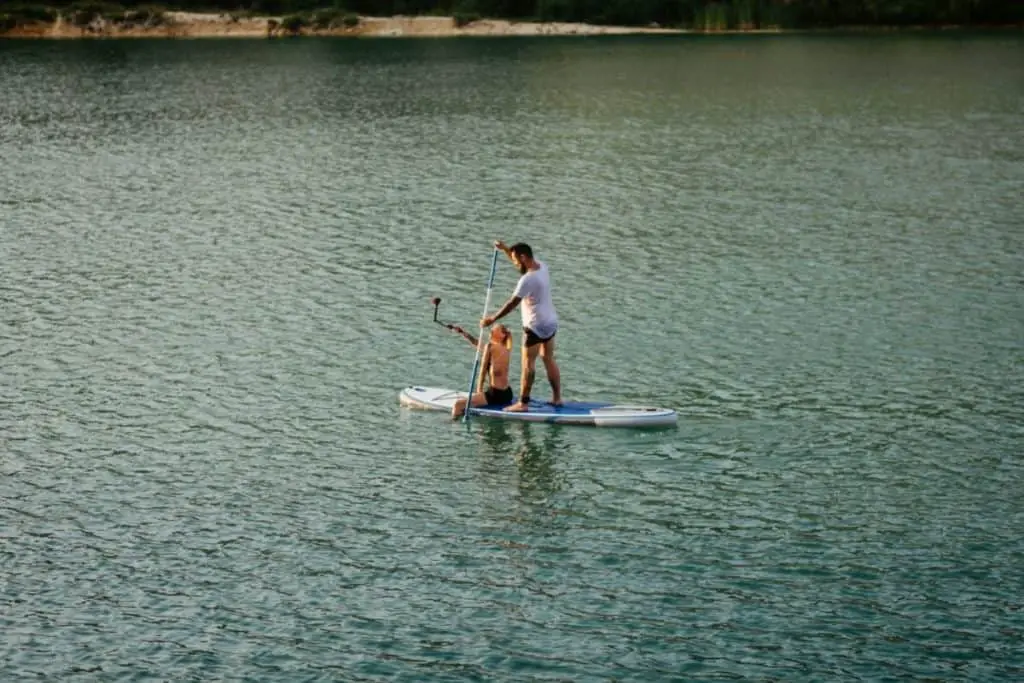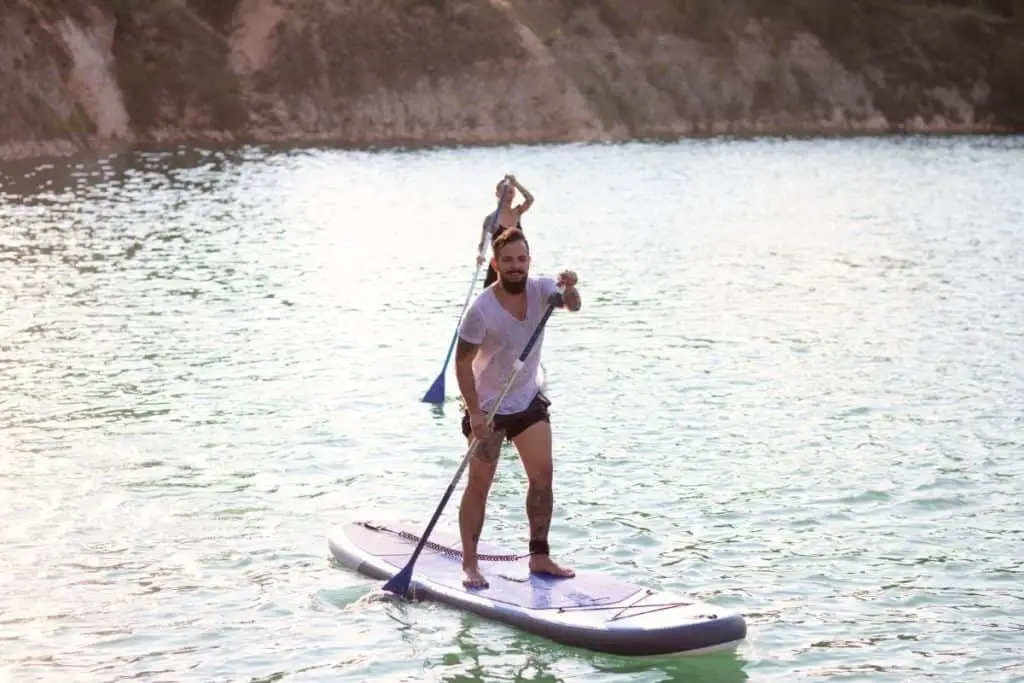As an Amazon Associate we earn from qualifying purchases.
If you are new to paddle boarding, you will be lucky to stay on the board for the first time. You won’t need to worry about how fast you will be able to paddle.
Nevertheless, if you have some experience paddle boarding, you might want to paddle a little faster and farther. If you are one of these people, you may wonder “How long does it take to paddleboard a mile?

Table of Contents
So, How Long Does That Take?
Since there are several factors that can influence your paddle boarding speed, it’s not an easy question to answer. The goal of this blog post is to discuss each factor and give you a good idea of how long you will need to paddleboard one mile.
How Long It Will Take To Go One Mile On A Paddle Board
It takes the average paddle boarder 30 minutes to paddle board 1 mile. This can be calculated based on the overall average speed which is 2-3 miles per hour.
Here are the key factors that will play a role in this exercise
Fitness And Experience Level
Your fitness level directly affects your speed. Depending on your physical capabilities and balance, you will be able to cover a mile faster if you are more athletic, agile, and fit.
Even if you are in good shape and have done many sports or other outdoor activities in the past, do not expect to fly across the water when you first start out. Fitness does help, but paddle boarding is not the same as running. There are other skills needed.
You will gain speed with practice, so going a mile at first will take a lot longer than for an experienced paddler.
In other words, seasoned paddle boarders will cover a mile much faster than someone who is brand new to the sport.
As with any exercise, you will achieve more results the more your body gets accustomed to it. Paddle boarding is no different. You will be able to go further every time you paddle board as you become better at it.
For someone with insufficient experience, going one mile can take a long time due to many different factors.
Their paddling technique is one factor. It takes a few tries to find the right paddling technique for your body and board when you are first starting out.
Before you really become an expert, you will have to go through a few trial-and-error rounds on your board.
The majority of you will go through this when you are first starting, but of course this does slow you down. Although many of you will catch on quickly, no one is going to just hop on a board and do it perfectly the first time they try.
An additional factor is balance. Paddle boarding intensely tests your balance and core strength. As with any balance test, sometimes you will fall. Especially with paddle boarding, it is almost inevitable.
Understanding how to move your arms without shifting your entire body can be a difficult challenge for anyone, and no one will know this better than a paddle boarder.
So how does balance play a factor in distance travelled? Well, when you lose your balance and fall, you will need to take the time to get back up on your board. This would make achieving a mile take a lot longer.
Additionally, there are a variety of different methods of paddle boarding that will affect how fast you cover a mile. If you are paddle board racing, then you will cover more distance compared to if you were just having a casual boarding experience.
Some people also like to take a break and even do yoga exercises on their board as well, which does not count towards distance but certainly gives you a great workout.
| Experience | Speed | 1 Mile Time |
| Beginner | 2-3 MPH | 30 minutes to 20 minutes |
| Intermediate | 3-4 MPH | 20 minutes to 15 minutes |
| Experienced | 4-5 MPH | 15 minutes to 12 minutes |
| Professional | 5-7 MPH | 12 minutes to 8.5 minutes |

What Types Of Paddle Boards Will Make A Big Difference In SUP Speed And Distance
Paddle boards often come in a few varieties depending on your specific needs. As an example, they make separate boards for kids that are easier to control and lighter than adult boards. However, in terms of adult boards there are different varieties to choose from.
All Rounders
All rounders are the best boards for beginners, but many experienced paddlers love them too. They tend to be wider than other boards which makes it easier for you to balance.
These will not move you quite as fast as other board types, but they will help you stay balanced which could shorten your mile time and help assist you from falling. Also, these boards are great for flat water and fishing.
Family Style
Family boards are made so that the whole family can use them. The wide nose and stable tail make it far easier for anyone to balance on these boards.
Although they will be slower than the all rounders due to their style and design, the family style boards are great for bringing your dog or kids along for the ride with you.
If you are a beginner, then this option is highly recommended for you as these boards make it easier to keep your balance. Also, you won’t be able to move as quickly as other boards making it a perfect board for those who are trying to develop their skills.
Racing/Touring
Racing or touring boards are longer and thinner than family style and all rounder boards. This means that being able to balance is more difficult but the long, thin design allows paddlers to move a lot faster.
If you decide to use one of these boards, then it will definitely take less time to cover a mile as long as you have the correct experience to handle this board.
Additionally, these boards will often move straighter than other boards because they are not as wide. Therefore, they are easier to control if you can keep your balance.
Inflatable
People like to use inflatable boards for their limited space, easy transportation and whitewater paddling. These are often highly recommended for anyone that uses their board around rocks or if they are expecting their board to get a little beat up whilst using it.
As they are inflated, they are a little more comfortable than original boards but inflatable boards will not move as fast as solid boards. Therefore, if this is the board you choose, it will take longer for you to complete a mile if that is your goal.
Size Of Paddle Boards
When it comes to selecting your board. There are many different sizes to choose from. Usually, the thinner and longer your board, the faster you will go. There are a few factors that will determine how fast you will be able to go when it comes to paddle board styles.
Length
The board length is an important factor. Short boards are the slowest, but also will be the easiest to control. Medium length boards will be able to travel a little faster. Most all rounders are this size. Lastly, longboards are the fastest boards as they are built with a sleeker design for speed.
Width
In terms of achieving top speed, width is a very important factor. Although wider boards do make balance easier, they also slow you down.
Therefore, when considering the width of your board, keep in mind that balance will come with experience. However, a board that is too wide for you can be difficult to paddle and will slow you down. Wide boards are still great for beginners and great to practice on especially when you are not focused on speed first.
Thickness
When you choose the thickness of your board, this will determine how much weight it can support. If a thin person is using a thick board, then they may find it difficult to control and manage speed.
This is not as simple as saying that thinner boards go faster as if you get a board that is too thin, then there may be a weight capacity issue.
To find out what best suits you, it really comes down to testing out different boards over time and getting more and more experience. Once you find that you are comfortable, you will know which board is perfect for you, your size and strength.
Final Thoughts
Whether you are completely inexperienced or a seasoned professional, you should now know how long it takes to paddle board a mile.
As well as this, you will now be aware of the next steps you need to take to become even faster by upgrading your paddle board and looking out for key factors that may hinder your progress.
Amazon and the Amazon logo are trademarks of Amazon.com, Inc, or its affiliates.

